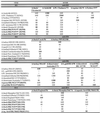Characterization of the influenza A virus gene pool in avian species in southern China: was H6N1 a derivative or a precursor of H5N1?
- PMID: 10864640
- PMCID: PMC112136
- DOI: 10.1128/jvi.74.14.6309-6315.2000
Characterization of the influenza A virus gene pool in avian species in southern China: was H6N1 a derivative or a precursor of H5N1?
Abstract
In 1997, an H5N1 influenza virus outbreak occurred in chickens in Hong Kong, and the virus was transmitted directly to humans. Because there is limited information about the avian influenza virus reservoir in that region, we genetically characterized virus strains isolated in Hong Kong during the 1997 outbreak. We sequenced the gene segments of a heterogeneous group of viruses of seven different serotypes (H3N8, H4N8, H6N1, H6N9, H11N1, H11N9, and H11N8) isolated from various bird species. The phylogenetic relationships divided these viruses into several subgroups. An H6N1 virus isolated from teal (A/teal/Hong Kong/W312/97 [H6N1]) showed very high (>98%) nucleotide homology to the human influenza virus A/Hong Kong/156/97 (H5N1) in the six internal genes. The N1 neuraminidase sequence showed 97% nucleotide homology to that of the human H5N1 virus, and the N1 protein of both viruses had the same 19-amino-acid deletion in the stalk region. The deduced hemagglutinin amino acid sequence of the H6N1 virus was most similar to that of A/shearwater/Australia/1/72 (H6N5). The H6N1 virus is the first known isolate with seven H5N1-like segments and may have been the donor of the neuraminidase and the internal genes of the H5N1 viruses. The high homology between the internal genes of H9N2, H6N1, and the H5N1 isolates indicates that these subtypes are able to exchange their internal genes and are therefore a potential source of new pathogenic influenza virus strains. Our analysis suggests that surveillance for influenza A viruses should be conducted for wild aquatic birds as well as for poultry, pigs, and humans and that H6 isolates should be further characterized.
Figures



References
-
- Bender C, Hall H, Huang J, Klimov A, Cox N, Hay A, Gregory V, Cameron K, Lim W, Subbarao K. Characterization of the surface proteins of influenza A (H5N1) viruses isolated from humans in 1997–1998. Virology. 1999;254:115–123. - PubMed
-
- Bosch F X, Garten W, Klenk H D, Rott R. Proteolytic cleavage of influenza virus hemagglutinins: primary structure of the connecting peptide between HA1 and HA2 determines proteolytic cleavability and pathogenicity of avian influenza viruses. Virology. 1981;113:725–735. - PubMed
-
- Claas E C, Osterhaus A D, van Beek R, de Jong J C, Rimmelzwaan G F, Senne D A, Krauss S, Shortridge K F, Webster R G. Human influenza A H5N1 virus related to a highly pathogenic avian influenza virus. Lancet. 1998;351:472–477. - PubMed
Publication types
MeSH terms
Substances
Grants and funding
LinkOut - more resources
Full Text Sources
Other Literature Sources
Medical

